Anatomy and Physiology
VerifiedAdded on 2023/01/12
|11
|2031
|29
AI Summary
This document provides an overview of the study of Anatomy and Physiology. It covers topics such as anatomical terminology, physiological principles of key body systems, independent literature research, and the relationship between the structure and function of key systems and their organs.
Contribute Materials
Your contribution can guide someone’s learning journey. Share your
documents today.
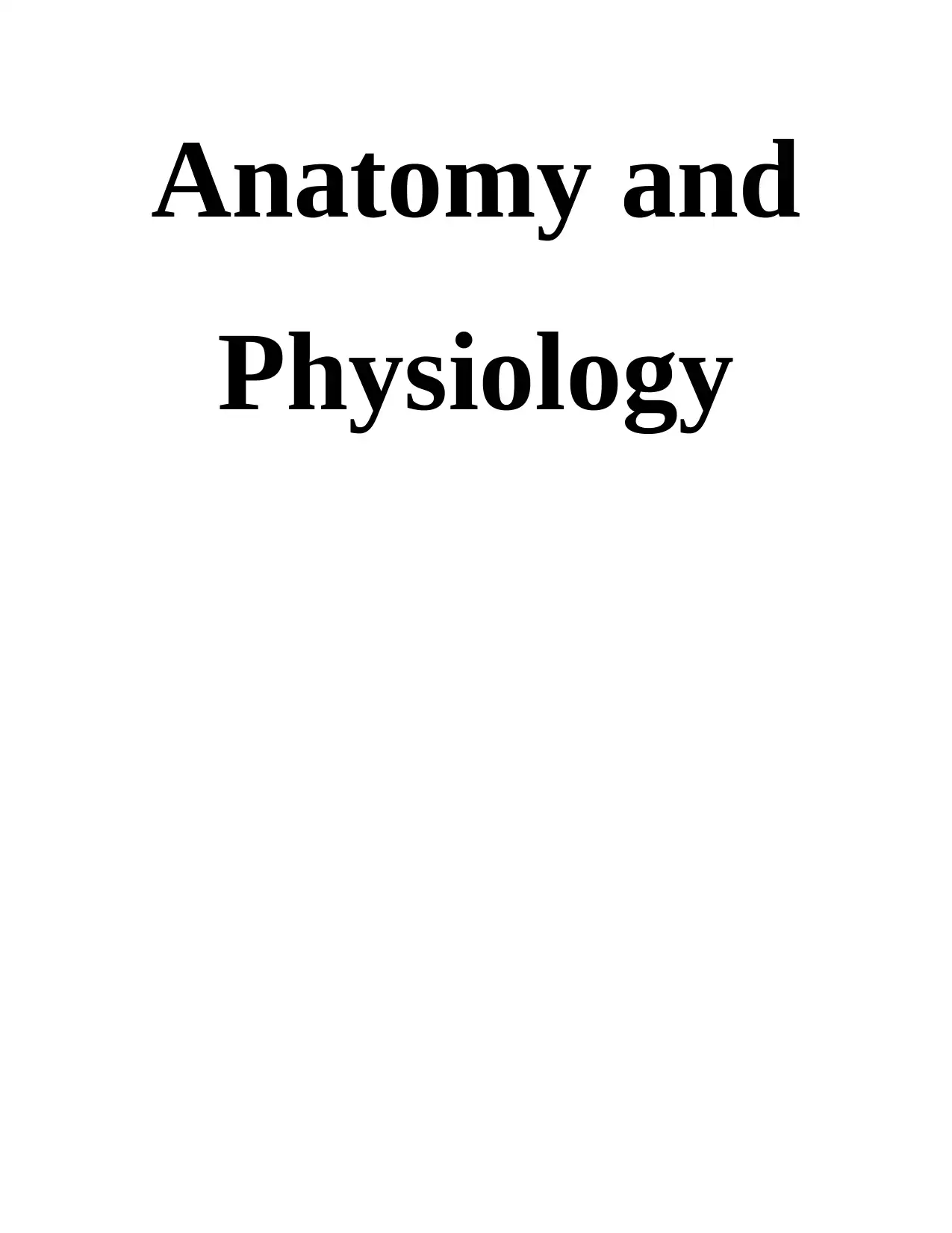
Anatomy and
Physiology
Physiology
Secure Best Marks with AI Grader
Need help grading? Try our AI Grader for instant feedback on your assignments.
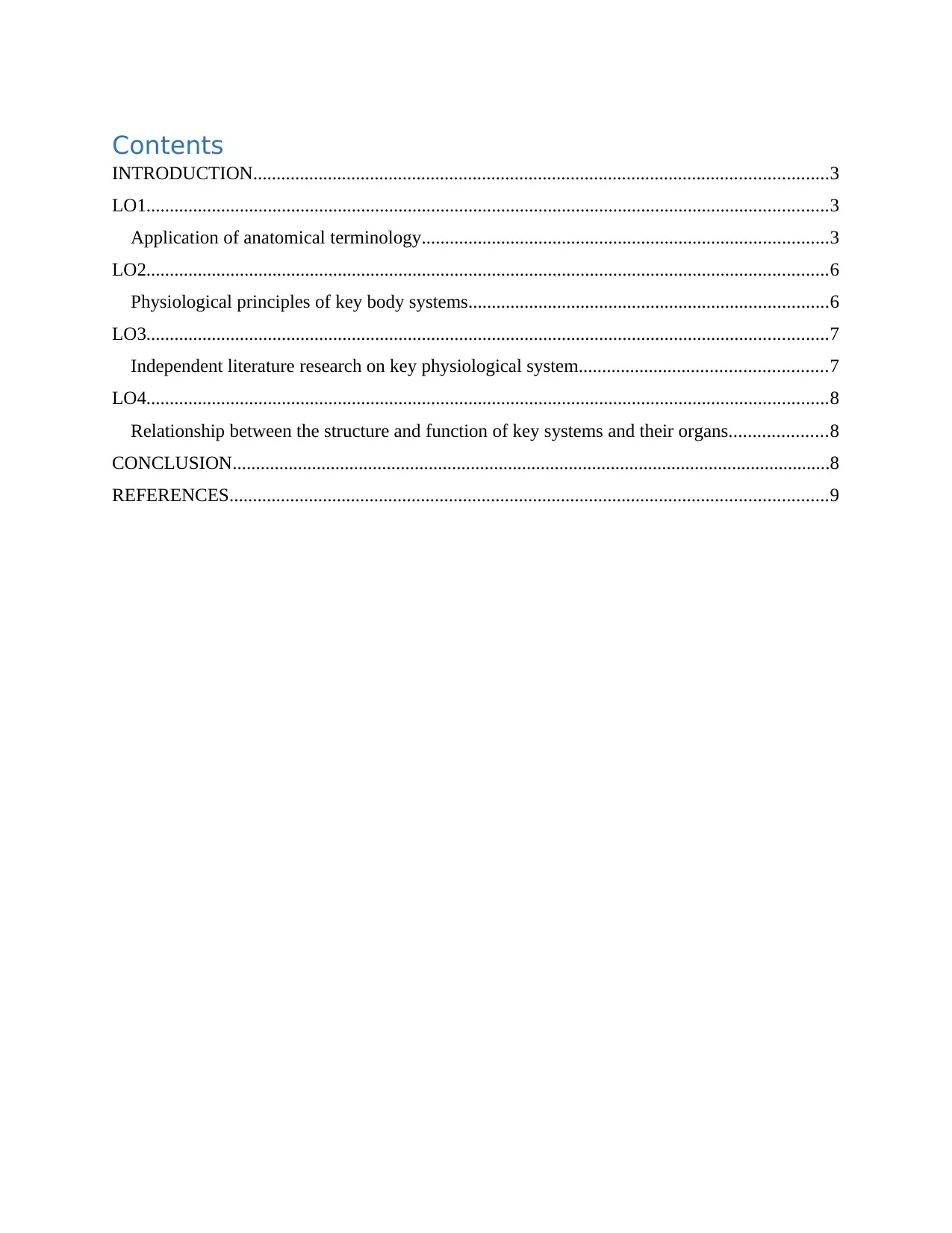
Contents
INTRODUCTION...........................................................................................................................3
LO1..................................................................................................................................................3
Application of anatomical terminology.......................................................................................3
LO2..................................................................................................................................................6
Physiological principles of key body systems.............................................................................6
LO3..................................................................................................................................................7
Independent literature research on key physiological system.....................................................7
LO4..................................................................................................................................................8
Relationship between the structure and function of key systems and their organs.....................8
CONCLUSION................................................................................................................................8
REFERENCES................................................................................................................................9
INTRODUCTION...........................................................................................................................3
LO1..................................................................................................................................................3
Application of anatomical terminology.......................................................................................3
LO2..................................................................................................................................................6
Physiological principles of key body systems.............................................................................6
LO3..................................................................................................................................................7
Independent literature research on key physiological system.....................................................7
LO4..................................................................................................................................................8
Relationship between the structure and function of key systems and their organs.....................8
CONCLUSION................................................................................................................................8
REFERENCES................................................................................................................................9
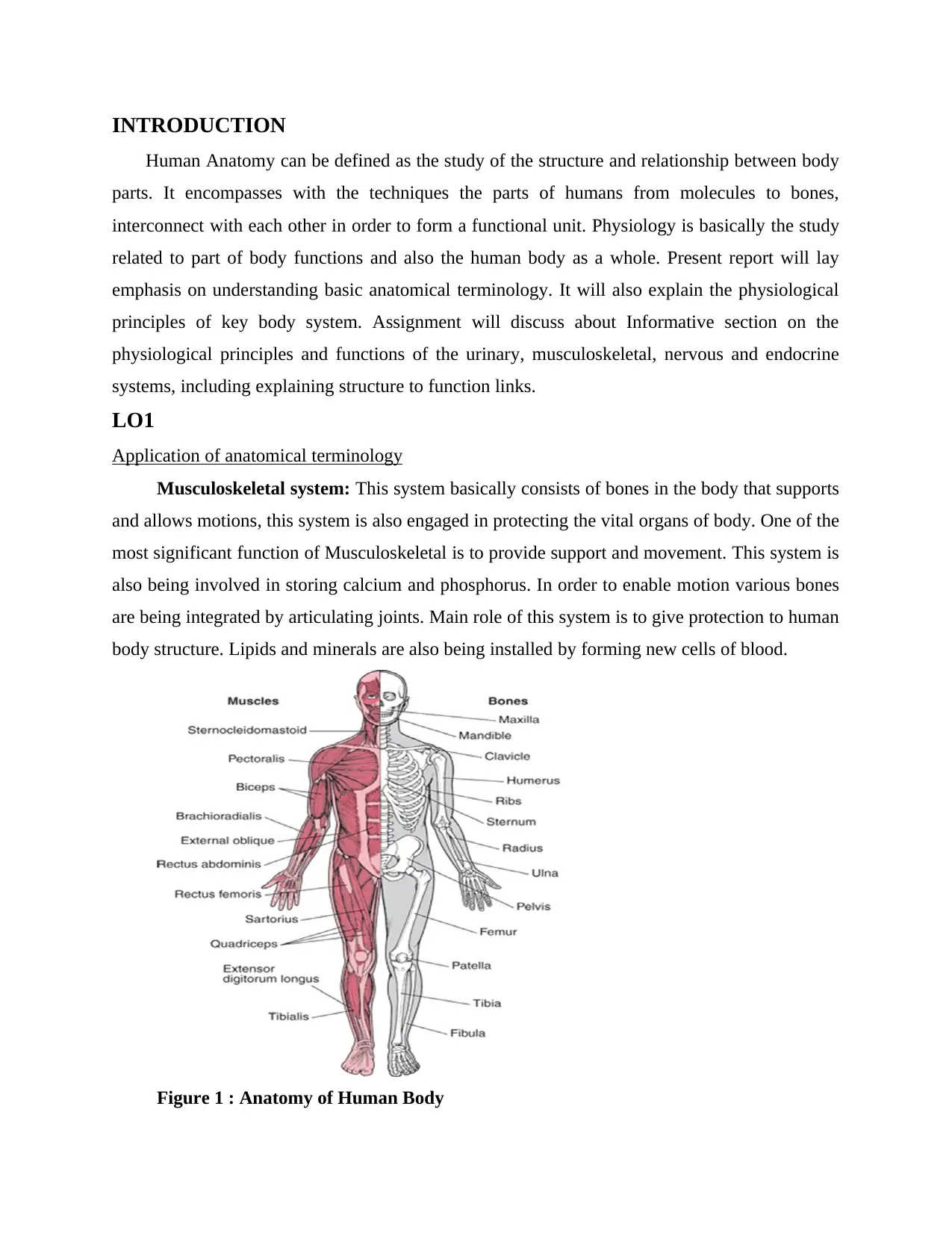
INTRODUCTION
Human Anatomy can be defined as the study of the structure and relationship between body
parts. It encompasses with the techniques the parts of humans from molecules to bones,
interconnect with each other in order to form a functional unit. Physiology is basically the study
related to part of body functions and also the human body as a whole. Present report will lay
emphasis on understanding basic anatomical terminology. It will also explain the physiological
principles of key body system. Assignment will discuss about Informative section on the
physiological principles and functions of the urinary, musculoskeletal, nervous and endocrine
systems, including explaining structure to function links.
LO1
Application of anatomical terminology
Musculoskeletal system: This system basically consists of bones in the body that supports
and allows motions, this system is also engaged in protecting the vital organs of body. One of the
most significant function of Musculoskeletal is to provide support and movement. This system is
also being involved in storing calcium and phosphorus. In order to enable motion various bones
are being integrated by articulating joints. Main role of this system is to give protection to human
body structure. Lipids and minerals are also being installed by forming new cells of blood.
Figure 1 : Anatomy of Human Body
Human Anatomy can be defined as the study of the structure and relationship between body
parts. It encompasses with the techniques the parts of humans from molecules to bones,
interconnect with each other in order to form a functional unit. Physiology is basically the study
related to part of body functions and also the human body as a whole. Present report will lay
emphasis on understanding basic anatomical terminology. It will also explain the physiological
principles of key body system. Assignment will discuss about Informative section on the
physiological principles and functions of the urinary, musculoskeletal, nervous and endocrine
systems, including explaining structure to function links.
LO1
Application of anatomical terminology
Musculoskeletal system: This system basically consists of bones in the body that supports
and allows motions, this system is also engaged in protecting the vital organs of body. One of the
most significant function of Musculoskeletal is to provide support and movement. This system is
also being involved in storing calcium and phosphorus. In order to enable motion various bones
are being integrated by articulating joints. Main role of this system is to give protection to human
body structure. Lipids and minerals are also being installed by forming new cells of blood.
Figure 1 : Anatomy of Human Body

(Source: rimo, Ghebremedhin and Gelpi, 2018)
Urinary system: This system is also known as renal or urinary tract system. Main purpose
this system is to pass out waste material from the human body. Regulation related to pressure of
blood and volume of blood is also being done by this system. It has been analysed that urine is
being prepared in the kidneys by filtering blood. After that urine is being passed from ureters to
the bladder and the bladder stores. When human body urinates, urine passes from bladder
through urethra to the outside of body.
Figure 2: Urinary System of Human Body
(Source: Tortora and Derrickson, 2018 )
Nervous system: This system in body is basically divided in two parts one is central
nervous system and other one is peripheral nervous system. CNS major parts includes the brain
and spinal cord. One of the major function of nervous system is to pass signals from the CNS
brain to the whole body and also vice versa. It is engaged in basically having control over the
ability to move, breathe, think and see. Human Body is stable because of this system.
Urinary system: This system is also known as renal or urinary tract system. Main purpose
this system is to pass out waste material from the human body. Regulation related to pressure of
blood and volume of blood is also being done by this system. It has been analysed that urine is
being prepared in the kidneys by filtering blood. After that urine is being passed from ureters to
the bladder and the bladder stores. When human body urinates, urine passes from bladder
through urethra to the outside of body.
Figure 2: Urinary System of Human Body
(Source: Tortora and Derrickson, 2018 )
Nervous system: This system in body is basically divided in two parts one is central
nervous system and other one is peripheral nervous system. CNS major parts includes the brain
and spinal cord. One of the major function of nervous system is to pass signals from the CNS
brain to the whole body and also vice versa. It is engaged in basically having control over the
ability to move, breathe, think and see. Human Body is stable because of this system.
Secure Best Marks with AI Grader
Need help grading? Try our AI Grader for instant feedback on your assignments.
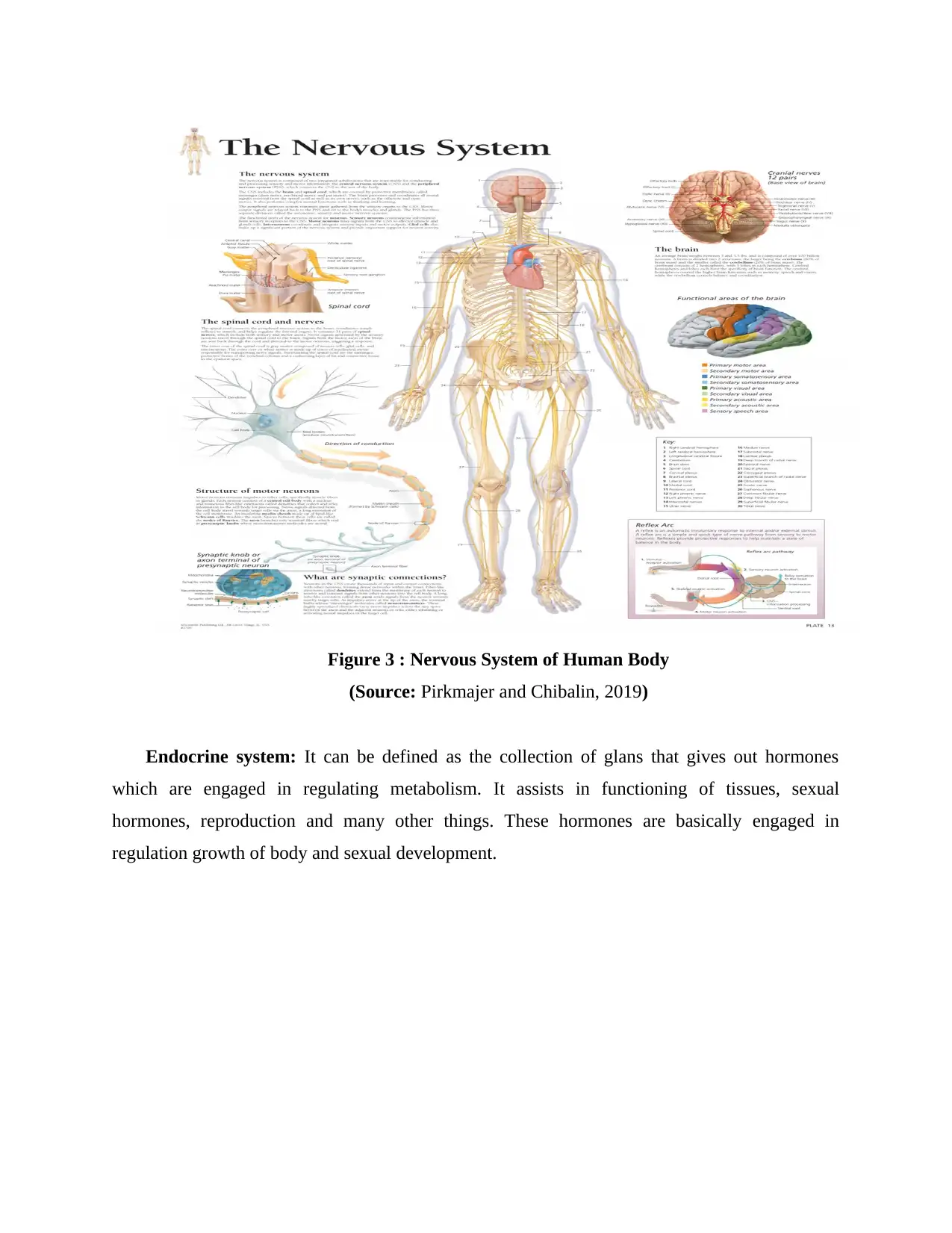
Figure 3 : Nervous System of Human Body
(Source: Pirkmajer and Chibalin, 2019)
Endocrine system: It can be defined as the collection of glans that gives out hormones
which are engaged in regulating metabolism. It assists in functioning of tissues, sexual
hormones, reproduction and many other things. These hormones are basically engaged in
regulation growth of body and sexual development.
(Source: Pirkmajer and Chibalin, 2019)
Endocrine system: It can be defined as the collection of glans that gives out hormones
which are engaged in regulating metabolism. It assists in functioning of tissues, sexual
hormones, reproduction and many other things. These hormones are basically engaged in
regulation growth of body and sexual development.

Figure 4 : Endocrine System of Human Body
(Source: Knight, 2018)
LO2
Physiological principles of key body systems
The central principle of physiology is homeostasis. This can be defined as the ability to
maintain the stability which is internal in human body so that it is very easy for them to
compensate for changes in environment. One of the example haemostasis is that human body
maintains an average temperature of 98.6 degree. The major organs which helps in maintaining
homeostasis are: human brain, kidney and liver. The physiological principle of key body system
includes the following:
Musculoskeletal system- This system is basically built up of the bones related to skeleton,
muscles, cartilage, joints and many other connective tissues. One of the main function of
musculoskeletal system is to enable motion and give protection to major organs in human body
part (Cruz, Lucio and Palacios, 2017). It provides support and movement to body and also is
engaged in protecting organs which are internal. Musculoskeletal system is engaged in producing
the cells related to blood. It makes sure that minerals and fats are stored in body parts. Structure
of this system consists of two parts one in is muscles system and other one is skeletal system.
They are being made up of soft and hard tissues.
Urinary system: Structure of renal system includes kidneys, ureters, bladders and urethra. It
has been analysed that lower urinary structures of male and females varies from each other in
(Source: Knight, 2018)
LO2
Physiological principles of key body systems
The central principle of physiology is homeostasis. This can be defined as the ability to
maintain the stability which is internal in human body so that it is very easy for them to
compensate for changes in environment. One of the example haemostasis is that human body
maintains an average temperature of 98.6 degree. The major organs which helps in maintaining
homeostasis are: human brain, kidney and liver. The physiological principle of key body system
includes the following:
Musculoskeletal system- This system is basically built up of the bones related to skeleton,
muscles, cartilage, joints and many other connective tissues. One of the main function of
musculoskeletal system is to enable motion and give protection to major organs in human body
part (Cruz, Lucio and Palacios, 2017). It provides support and movement to body and also is
engaged in protecting organs which are internal. Musculoskeletal system is engaged in producing
the cells related to blood. It makes sure that minerals and fats are stored in body parts. Structure
of this system consists of two parts one in is muscles system and other one is skeletal system.
They are being made up of soft and hard tissues.
Urinary system: Structure of renal system includes kidneys, ureters, bladders and urethra. It
has been analysed that lower urinary structures of male and females varies from each other in
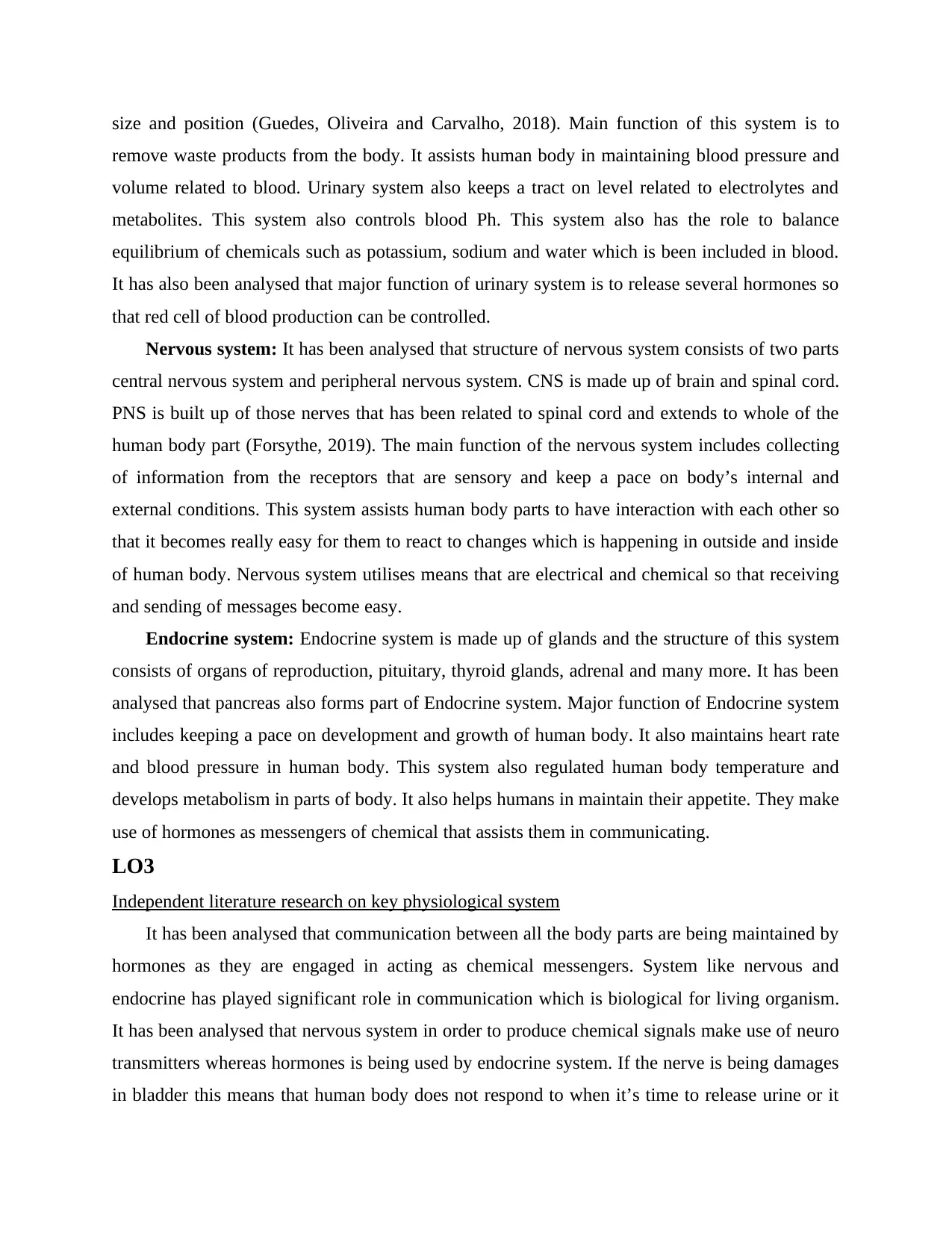
size and position (Guedes, Oliveira and Carvalho, 2018). Main function of this system is to
remove waste products from the body. It assists human body in maintaining blood pressure and
volume related to blood. Urinary system also keeps a tract on level related to electrolytes and
metabolites. This system also controls blood Ph. This system also has the role to balance
equilibrium of chemicals such as potassium, sodium and water which is been included in blood.
It has also been analysed that major function of urinary system is to release several hormones so
that red cell of blood production can be controlled.
Nervous system: It has been analysed that structure of nervous system consists of two parts
central nervous system and peripheral nervous system. CNS is made up of brain and spinal cord.
PNS is built up of those nerves that has been related to spinal cord and extends to whole of the
human body part (Forsythe, 2019). The main function of the nervous system includes collecting
of information from the receptors that are sensory and keep a pace on body’s internal and
external conditions. This system assists human body parts to have interaction with each other so
that it becomes really easy for them to react to changes which is happening in outside and inside
of human body. Nervous system utilises means that are electrical and chemical so that receiving
and sending of messages become easy.
Endocrine system: Endocrine system is made up of glands and the structure of this system
consists of organs of reproduction, pituitary, thyroid glands, adrenal and many more. It has been
analysed that pancreas also forms part of Endocrine system. Major function of Endocrine system
includes keeping a pace on development and growth of human body. It also maintains heart rate
and blood pressure in human body. This system also regulated human body temperature and
develops metabolism in parts of body. It also helps humans in maintain their appetite. They make
use of hormones as messengers of chemical that assists them in communicating.
LO3
Independent literature research on key physiological system
It has been analysed that communication between all the body parts are being maintained by
hormones as they are engaged in acting as chemical messengers. System like nervous and
endocrine has played significant role in communication which is biological for living organism.
It has been analysed that nervous system in order to produce chemical signals make use of neuro
transmitters whereas hormones is being used by endocrine system. If the nerve is being damages
in bladder this means that human body does not respond to when it’s time to release urine or it
remove waste products from the body. It assists human body in maintaining blood pressure and
volume related to blood. Urinary system also keeps a tract on level related to electrolytes and
metabolites. This system also controls blood Ph. This system also has the role to balance
equilibrium of chemicals such as potassium, sodium and water which is been included in blood.
It has also been analysed that major function of urinary system is to release several hormones so
that red cell of blood production can be controlled.
Nervous system: It has been analysed that structure of nervous system consists of two parts
central nervous system and peripheral nervous system. CNS is made up of brain and spinal cord.
PNS is built up of those nerves that has been related to spinal cord and extends to whole of the
human body part (Forsythe, 2019). The main function of the nervous system includes collecting
of information from the receptors that are sensory and keep a pace on body’s internal and
external conditions. This system assists human body parts to have interaction with each other so
that it becomes really easy for them to react to changes which is happening in outside and inside
of human body. Nervous system utilises means that are electrical and chemical so that receiving
and sending of messages become easy.
Endocrine system: Endocrine system is made up of glands and the structure of this system
consists of organs of reproduction, pituitary, thyroid glands, adrenal and many more. It has been
analysed that pancreas also forms part of Endocrine system. Major function of Endocrine system
includes keeping a pace on development and growth of human body. It also maintains heart rate
and blood pressure in human body. This system also regulated human body temperature and
develops metabolism in parts of body. It also helps humans in maintain their appetite. They make
use of hormones as messengers of chemical that assists them in communicating.
LO3
Independent literature research on key physiological system
It has been analysed that communication between all the body parts are being maintained by
hormones as they are engaged in acting as chemical messengers. System like nervous and
endocrine has played significant role in communication which is biological for living organism.
It has been analysed that nervous system in order to produce chemical signals make use of neuro
transmitters whereas hormones is being used by endocrine system. If the nerve is being damages
in bladder this means that human body does not respond to when it’s time to release urine or it
Paraphrase This Document
Need a fresh take? Get an instant paraphrase of this document with our AI Paraphraser
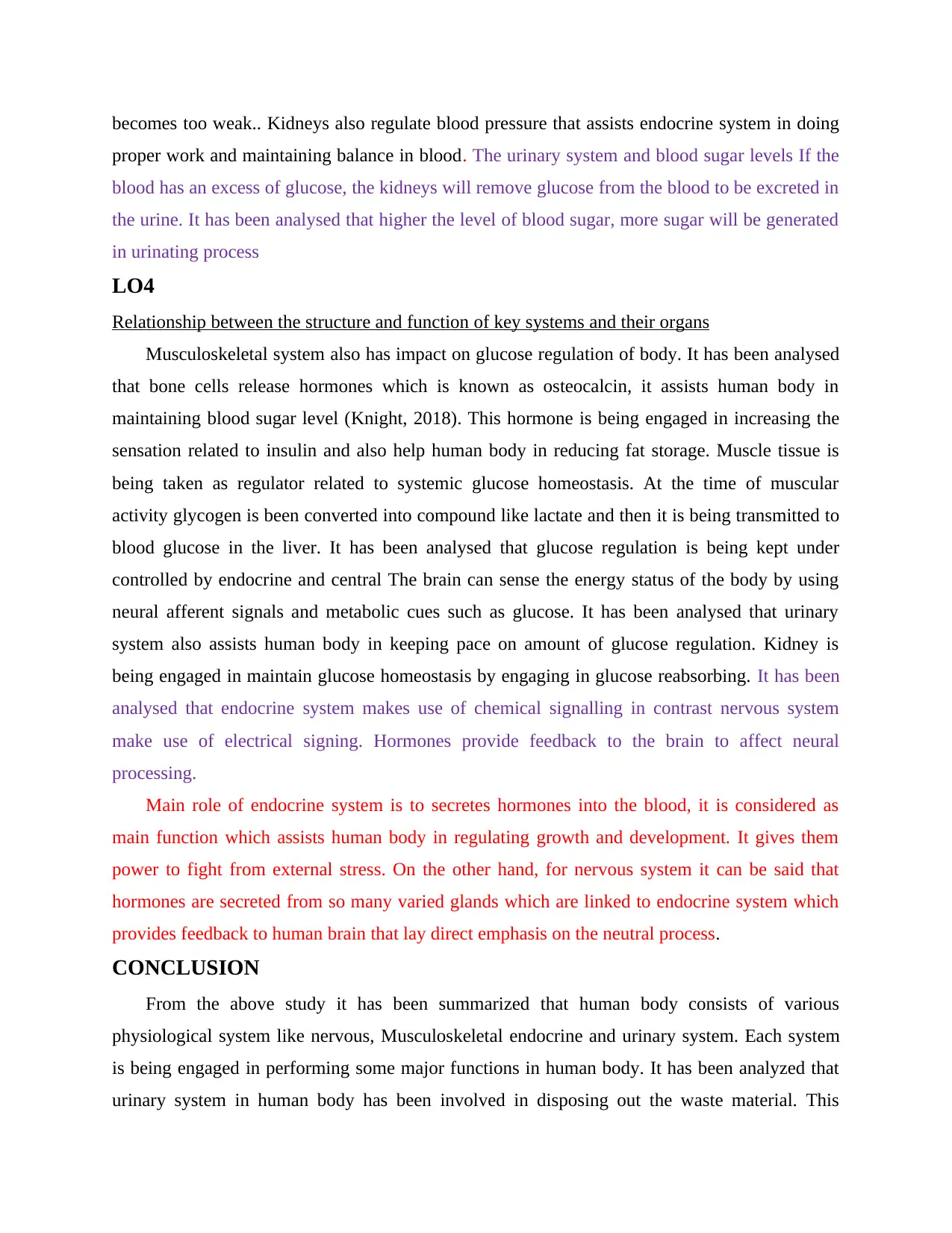
becomes too weak.. Kidneys also regulate blood pressure that assists endocrine system in doing
proper work and maintaining balance in blood. The urinary system and blood sugar levels If the
blood has an excess of glucose, the kidneys will remove glucose from the blood to be excreted in
the urine. It has been analysed that higher the level of blood sugar, more sugar will be generated
in urinating process
LO4
Relationship between the structure and function of key systems and their organs
Musculoskeletal system also has impact on glucose regulation of body. It has been analysed
that bone cells release hormones which is known as osteocalcin, it assists human body in
maintaining blood sugar level (Knight, 2018). This hormone is being engaged in increasing the
sensation related to insulin and also help human body in reducing fat storage. Muscle tissue is
being taken as regulator related to systemic glucose homeostasis. At the time of muscular
activity glycogen is been converted into compound like lactate and then it is being transmitted to
blood glucose in the liver. It has been analysed that glucose regulation is being kept under
controlled by endocrine and central The brain can sense the energy status of the body by using
neural afferent signals and metabolic cues such as glucose. It has been analysed that urinary
system also assists human body in keeping pace on amount of glucose regulation. Kidney is
being engaged in maintain glucose homeostasis by engaging in glucose reabsorbing. It has been
analysed that endocrine system makes use of chemical signalling in contrast nervous system
make use of electrical signing. Hormones provide feedback to the brain to affect neural
processing.
Main role of endocrine system is to secretes hormones into the blood, it is considered as
main function which assists human body in regulating growth and development. It gives them
power to fight from external stress. On the other hand, for nervous system it can be said that
hormones are secreted from so many varied glands which are linked to endocrine system which
provides feedback to human brain that lay direct emphasis on the neutral process.
CONCLUSION
From the above study it has been summarized that human body consists of various
physiological system like nervous, Musculoskeletal endocrine and urinary system. Each system
is being engaged in performing some major functions in human body. It has been analyzed that
urinary system in human body has been involved in disposing out the waste material. This
proper work and maintaining balance in blood. The urinary system and blood sugar levels If the
blood has an excess of glucose, the kidneys will remove glucose from the blood to be excreted in
the urine. It has been analysed that higher the level of blood sugar, more sugar will be generated
in urinating process
LO4
Relationship between the structure and function of key systems and their organs
Musculoskeletal system also has impact on glucose regulation of body. It has been analysed
that bone cells release hormones which is known as osteocalcin, it assists human body in
maintaining blood sugar level (Knight, 2018). This hormone is being engaged in increasing the
sensation related to insulin and also help human body in reducing fat storage. Muscle tissue is
being taken as regulator related to systemic glucose homeostasis. At the time of muscular
activity glycogen is been converted into compound like lactate and then it is being transmitted to
blood glucose in the liver. It has been analysed that glucose regulation is being kept under
controlled by endocrine and central The brain can sense the energy status of the body by using
neural afferent signals and metabolic cues such as glucose. It has been analysed that urinary
system also assists human body in keeping pace on amount of glucose regulation. Kidney is
being engaged in maintain glucose homeostasis by engaging in glucose reabsorbing. It has been
analysed that endocrine system makes use of chemical signalling in contrast nervous system
make use of electrical signing. Hormones provide feedback to the brain to affect neural
processing.
Main role of endocrine system is to secretes hormones into the blood, it is considered as
main function which assists human body in regulating growth and development. It gives them
power to fight from external stress. On the other hand, for nervous system it can be said that
hormones are secreted from so many varied glands which are linked to endocrine system which
provides feedback to human brain that lay direct emphasis on the neutral process.
CONCLUSION
From the above study it has been summarized that human body consists of various
physiological system like nervous, Musculoskeletal endocrine and urinary system. Each system
is being engaged in performing some major functions in human body. It has been analyzed that
urinary system in human body has been involved in disposing out the waste material. This
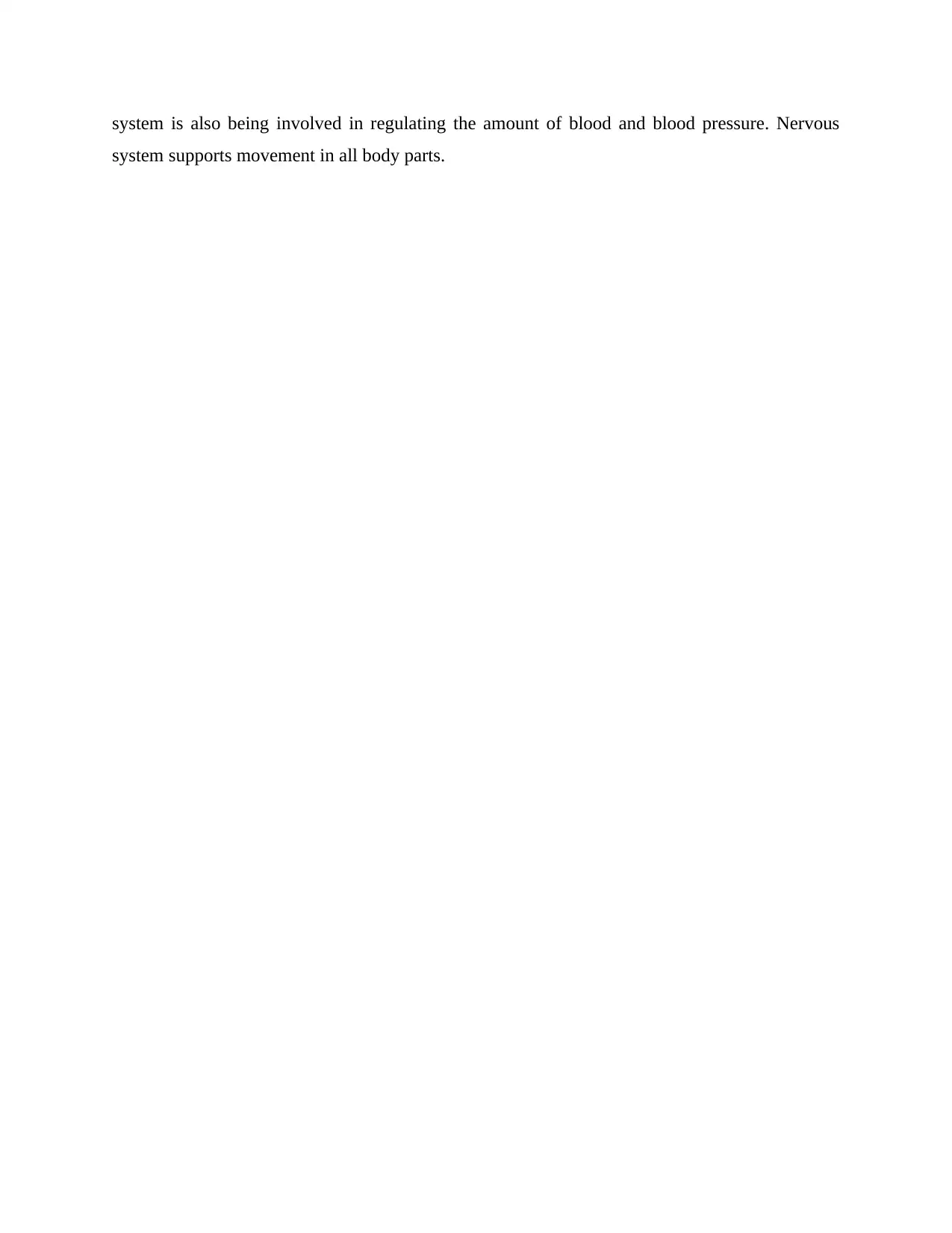
system is also being involved in regulating the amount of blood and blood pressure. Nervous
system supports movement in all body parts.
system supports movement in all body parts.
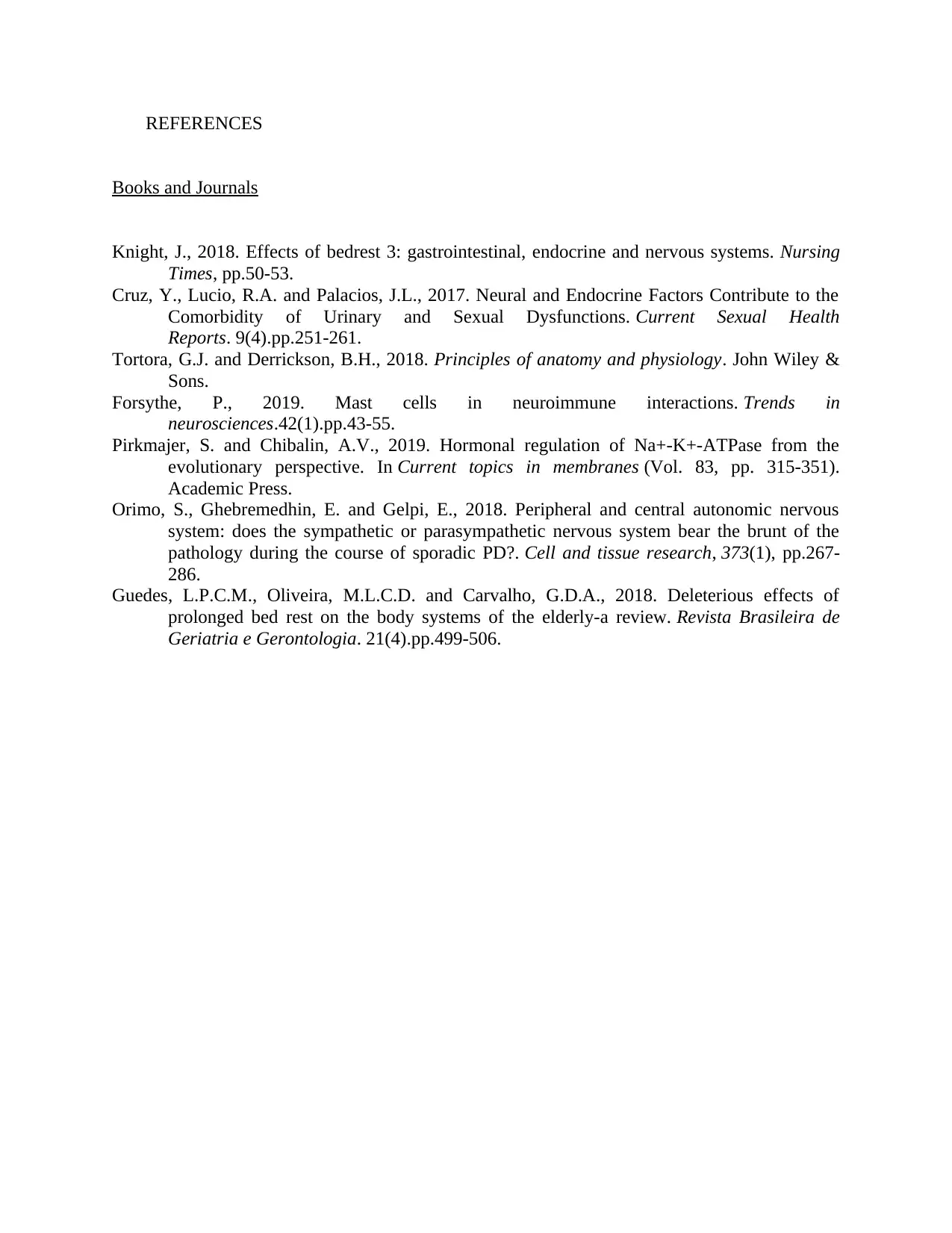
REFERENCES
Books and Journals
Knight, J., 2018. Effects of bedrest 3: gastrointestinal, endocrine and nervous systems. Nursing
Times, pp.50-53.
Cruz, Y., Lucio, R.A. and Palacios, J.L., 2017. Neural and Endocrine Factors Contribute to the
Comorbidity of Urinary and Sexual Dysfunctions. Current Sexual Health
Reports. 9(4).pp.251-261.
Tortora, G.J. and Derrickson, B.H., 2018. Principles of anatomy and physiology. John Wiley &
Sons.
Forsythe, P., 2019. Mast cells in neuroimmune interactions. Trends in
neurosciences.42(1).pp.43-55.
Pirkmajer, S. and Chibalin, A.V., 2019. Hormonal regulation of Na+-K+-ATPase from the
evolutionary perspective. In Current topics in membranes (Vol. 83, pp. 315-351).
Academic Press.
Orimo, S., Ghebremedhin, E. and Gelpi, E., 2018. Peripheral and central autonomic nervous
system: does the sympathetic or parasympathetic nervous system bear the brunt of the
pathology during the course of sporadic PD?. Cell and tissue research, 373(1), pp.267-
286.
Guedes, L.P.C.M., Oliveira, M.L.C.D. and Carvalho, G.D.A., 2018. Deleterious effects of
prolonged bed rest on the body systems of the elderly-a review. Revista Brasileira de
Geriatria e Gerontologia. 21(4).pp.499-506.
Books and Journals
Knight, J., 2018. Effects of bedrest 3: gastrointestinal, endocrine and nervous systems. Nursing
Times, pp.50-53.
Cruz, Y., Lucio, R.A. and Palacios, J.L., 2017. Neural and Endocrine Factors Contribute to the
Comorbidity of Urinary and Sexual Dysfunctions. Current Sexual Health
Reports. 9(4).pp.251-261.
Tortora, G.J. and Derrickson, B.H., 2018. Principles of anatomy and physiology. John Wiley &
Sons.
Forsythe, P., 2019. Mast cells in neuroimmune interactions. Trends in
neurosciences.42(1).pp.43-55.
Pirkmajer, S. and Chibalin, A.V., 2019. Hormonal regulation of Na+-K+-ATPase from the
evolutionary perspective. In Current topics in membranes (Vol. 83, pp. 315-351).
Academic Press.
Orimo, S., Ghebremedhin, E. and Gelpi, E., 2018. Peripheral and central autonomic nervous
system: does the sympathetic or parasympathetic nervous system bear the brunt of the
pathology during the course of sporadic PD?. Cell and tissue research, 373(1), pp.267-
286.
Guedes, L.P.C.M., Oliveira, M.L.C.D. and Carvalho, G.D.A., 2018. Deleterious effects of
prolonged bed rest on the body systems of the elderly-a review. Revista Brasileira de
Geriatria e Gerontologia. 21(4).pp.499-506.
Secure Best Marks with AI Grader
Need help grading? Try our AI Grader for instant feedback on your assignments.

1
1 out of 11
Related Documents
Your All-in-One AI-Powered Toolkit for Academic Success.
+13062052269
info@desklib.com
Available 24*7 on WhatsApp / Email
![[object Object]](/_next/static/media/star-bottom.7253800d.svg)
Unlock your academic potential
© 2024 | Zucol Services PVT LTD | All rights reserved.





